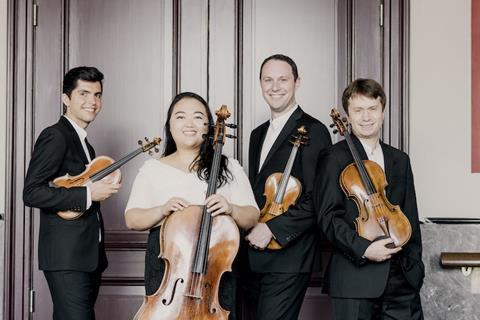To tie in with their latest release, the Calidore Quartet reflects on the experience of working with the contemporary composer Caroline Shaw

Music, like many of the other performing arts, is not a static object of beauty, but rather a framework of directions and patterns that beg to be interpreted and reinterpreted to ensure their survival for future audiences. No experience highlights this process more clearly than a successful collaboration between a performer and a composer.
As music students, we had very few, if any, chances to work directly with the composer whose music we were studying. It was not until we came together as a string quartet, exactly one decade ago, that we were able to choose contemporary voices that resonated with our own musical sensibilities. One of our most rewarding of these creative collaborations was with the American composer Caroline Shaw.
Our relationship with Caroline Shaw goes back over a decade when our cellist Estelle and Caroline played in a string quartet together as students at the Yale School of Music. As a quartet we were first drawn to her piece ‘Entr’acte’ (https://youtu.be/5JvFLBe7hWg) and quickly made it part of our concert programming. A couple of years later we asked Caroline, by then the youngest recipient of the Pulitzer Prize for Music, to write a piece for us. The result was her ‘First Essay: Nimrod’, included on our newest album ‘Babel’ released October 23rd.
The premiere of Caroline’s ‘First Essay’ took place at SOKA University in Orange County, CA in 2016. The dress rehearsal was our first opportunity to work together on the piece and we used it to check our interpretation with her vision of the work. In the rehearsals leading up to the performance we wrestled with tempi, bowings and matching articulations in order to unite our sounds and gestures with one another. Caroline was open to many of the ideas we formulated in our rehearsals of the piece. Adding slurs, changing tempo markings and even changing the ending from pizzicato to arco were all ideas she was interested to explore.
Read: Calidore Quartet: Resilience
Read: Calidore Quartet: Babel
While encouraging us to follow our instincts, she provided further insight to the inspiration behind her markings, such as ‘as if Tilda Swinton was reciting the Gettysburg Address’ or ‘with a Midwest lilt’. Beneath these witty indications was a serious commentary about language and how we use it. Many of the sections evoke the rhythms of words, following the lilt and flow of a seasoned storyteller or public speaker. In other sections she breaks up the four lines into a cacophony of sound referencing both the divisive rhetoric of the 2016 US presidential election and the biblical story of Babel from which the piece derives its title ‘Nimrod’ (the leader of the city of Babel). Her intention was to take these dissimilar musical passages and weave them together into a cohesive piece of music. The piece demonstrated how music can connect even when language falls apart.
Thus, the true goal for our interpretation was made clear to us. Any discussions we had within the quartet over bowings, fingerings, dynamics and tempos could easily become superficial if we didn’t consider the primary motivation behind the music. Our job as the interpreters of the ‘First Essay’ was to highlight Caroline’s inventive transitions, in some instances by using extended effects like ponticello, in others by gradually manipulating the width of our vibrato, in order to emphasize the unlikely yet smooth connections of the piece’s inherently disparate parts.
Through our experience working on Caroline’s ‘First Essay’, we found a sense of freedom when returning to the quartets of Beethoven, Mozart, Schubert, Haydn and so many others that form the core of the repertoire. These composers, like Caroline, had a point of view on life that they used their music to express. Our job as interpreters is to understand exactly what that is and how to bring it to life using our own knowledge and experience to do so. No one way of phrasing, bowing, vibrating or not vibrating is the one true way of capturing the composer’s voice. Instead the music of the great composers gives us incredible creative license as performers as long as we do our diligence in understanding who they are and what motivated them. Whether that means reading biographies, studying the manuscripts or understanding their broader body of work, there are countless ways we can come to a deeper understanding of the perspective these composers of the past were trying to communicate. From that point, the only limit to our expression as performers is the boundaries of our own imagination.
For more information on the Calidore’s new album, click here: https://smarturl.it/Calidore-
To watch the quartet play a movement of Shostakovich’s String Quartet No.9, a piece that also features on the album, see below











































No comments yet